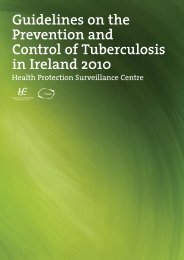Guidelines for the Early Clinical and Public Health Management of ...
Guidelines for the Early Clinical and Public Health Management of ...
Guidelines for the Early Clinical and Public Health Management of ...
Create successful ePaper yourself
Turn your PDF publications into a flip-book with our unique Google optimized e-Paper software.
<strong>Guidelines</strong> <strong>for</strong> <strong>the</strong> <strong>Early</strong> <strong>Clinical</strong> <strong>and</strong> <strong>Public</strong> <strong>Health</strong> <strong>Management</strong> <strong>of</strong> Bacterial Meningitis (including Meningococcal Disease)<br />
Chapter 8.<br />
<strong>Management</strong> <strong>of</strong> Clusters/ Outbreaks <strong>of</strong> Meningococcal<br />
Disease<br />
Key points<br />
• The objective <strong>of</strong> public health management <strong>of</strong> outbreaks is to interrupt <strong>the</strong> transmission <strong>of</strong><br />
disease <strong>and</strong> prevent fur<strong>the</strong>r cases occurring.<br />
• Clusters/outbreaks may be institution or organisation based or community based.<br />
8.1 Definitions<br />
An institution or organisation based outbreak <strong>of</strong> meningococcal disease:<br />
Two or more definite cases <strong>of</strong> meningococcal disease within a four-week period in a group with epidemiological links,<br />
AND where <strong>the</strong> available microbiological characterisation <strong>of</strong> <strong>the</strong> organisms is <strong>the</strong> same.<br />
A community based outbreak:<br />
Consider intervention if <strong>the</strong> age specific attack rate is “high”. Although a precise threshold <strong>for</strong> intervention has not been<br />
set, age-specific attack rates should be calculated. A minimum <strong>of</strong> four cases <strong>of</strong> definite meningococcal disease within<br />
a three-month interval, or 40/100,000 in any age group in a three-month period, in a geographical area that makes<br />
epidemiological sense AND where available microbiological characterisation <strong>of</strong> <strong>the</strong> organisms is <strong>the</strong> same. 3<br />
Decisions regarding chemoprophylaxis <strong>and</strong> vaccination (if appropriate) <strong>for</strong> a wider group than solely close contacts is<br />
dependent on local risk assessment.<br />
Easy to underst<strong>and</strong> written in<strong>for</strong>mation should be provided to all individuals regarding control measures taken (or not),<br />
early warning signs <strong>and</strong> contact details <strong>for</strong> follow-up advice.<br />
8. 2 Introduction<br />
Outbreaks may occur in <strong>the</strong> general community or in o<strong>the</strong>r settings such as schools <strong>and</strong> universities. The public health<br />
actions <strong>for</strong> each <strong>of</strong> <strong>the</strong>se settings may vary <strong>and</strong> will depend on <strong>the</strong> identification <strong>of</strong> epidemiological links between cases<br />
<strong>and</strong> identification that <strong>the</strong> same organism is associated with <strong>the</strong> outbreak cases.<br />
Outbreaks <strong>of</strong> invasive meningococcal disease need to be distinguished from increases <strong>of</strong> sporadic <strong>and</strong><br />
epidemiologically unlinked cases. Such increases may occur in <strong>the</strong> general community or within settings such as<br />
schools <strong>and</strong> crèches.<br />
When clustering <strong>of</strong> cases occurs local public health should look <strong>for</strong> epidemiological links between cases, even if <strong>the</strong>se<br />
are not immediately evident. Identification <strong>of</strong> such epi-links will in<strong>for</strong>m <strong>and</strong> direct public health control activities.<br />
The objective <strong>of</strong> public health management <strong>of</strong> such outbreaks <strong>of</strong> invasive meningococcal disease is to interrupt<br />
transmission <strong>and</strong> prevent fur<strong>the</strong>r cases. Once an outbreak is ei<strong>the</strong>r suspected or recognised <strong>the</strong>re is an immediate need<br />
to initiate a coordinated response. Elements <strong>of</strong> this response include:<br />
• Review available data to determine if <strong>the</strong>re is an outbreak <strong>and</strong> its extent.<br />
• Identify population at risk <strong>and</strong> calculation <strong>of</strong> age-specific <strong>and</strong> region-specific attack rates.<br />
• Establish an outbreak control team (OCT) <strong>and</strong> consider a site visit.<br />
• Identify those requiring chemoprophylaxis <strong>and</strong>/or immunisation.<br />
• Provide in<strong>for</strong>mation to all contacts <strong>and</strong> o<strong>the</strong>r persons involved.<br />
• Raise awareness <strong>and</strong> increase surveillance.<br />
• Provide adequate in<strong>for</strong>mation to health care providers, affected communities, <strong>the</strong> media <strong>and</strong> <strong>the</strong> general<br />
public.<br />
• Monitor <strong>and</strong> evaluate control measures <strong>and</strong> prepare final report.<br />
-67-

















